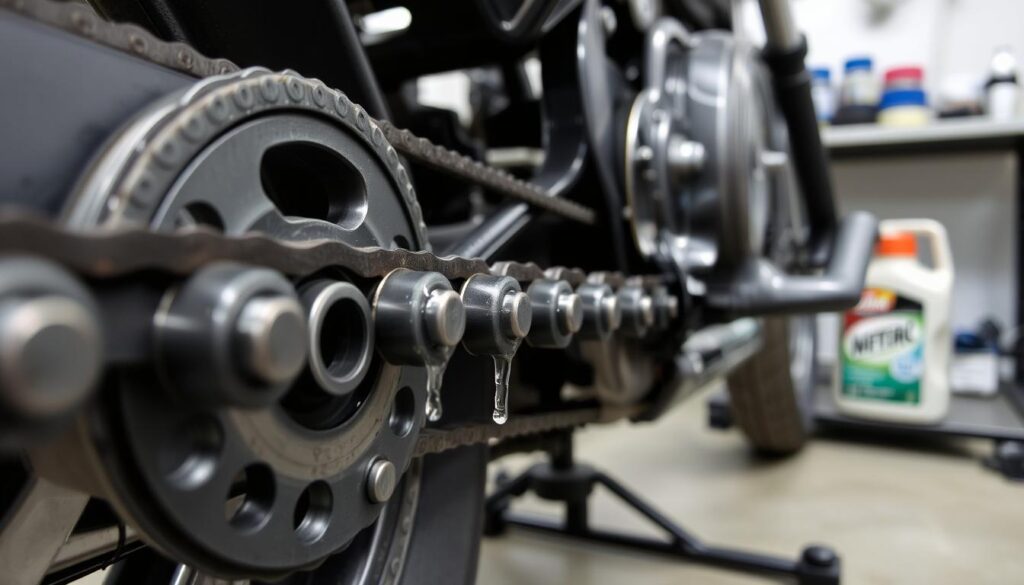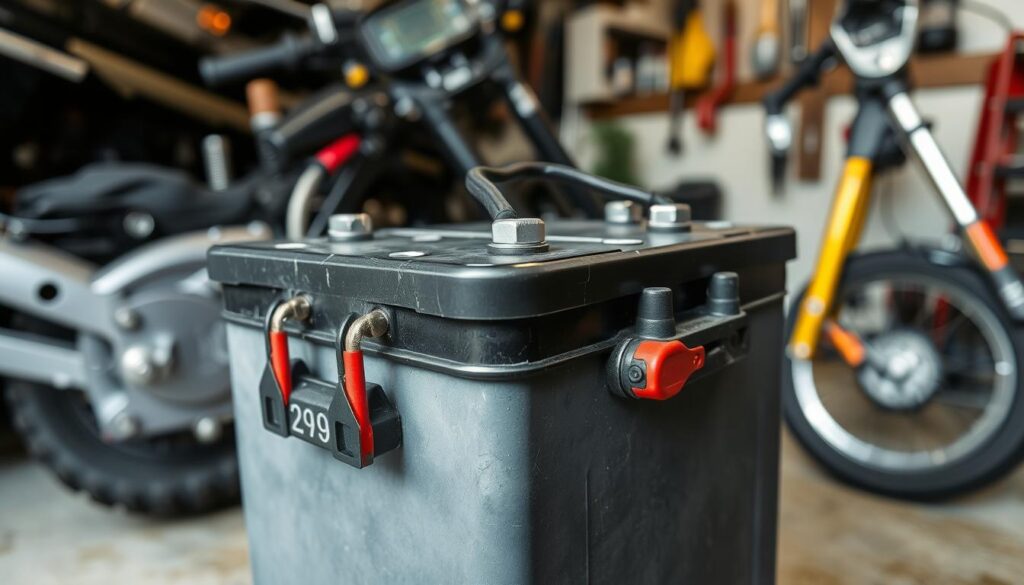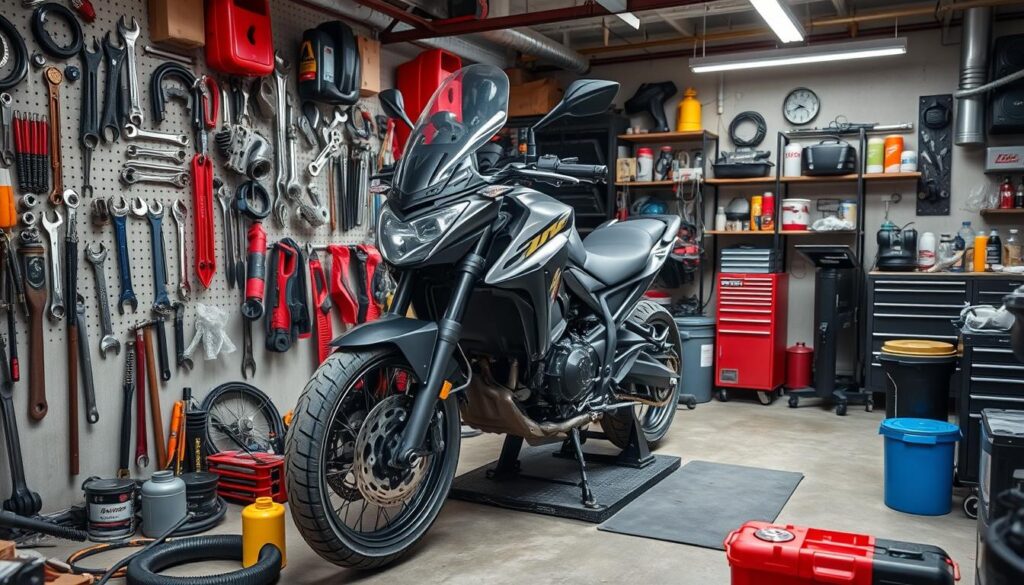As a motorcycle enthusiast, I love the thrill of riding and feeling the wind. But to enjoy the ride and keep your bike running well, regular maintenance is key. These tips will help you keep your motorcycle in top shape, whether you’re a seasoned rider or just starting out.
In This Guide
Understanding Basic Motorcycle Maintenance Tips
Keeping your motorcycle in good shape is key for its long life and your safety. Regular care stops expensive fixes and keeps your bike running well. Let’s explore why routine checks are vital, how to make a good maintenance plan, and the tools you need for DIY work.
Why Regular Maintenance Matters
Ignoring your motorcycle’s upkeep can cause many issues. These include bad fuel use, lower performance, and even serious mechanical failures. Regular checks and services can make your bike last longer, be more reliable, and even increase its value later.
Building Your Maintenance Schedule
- Check your owner’s manual for the recommended maintenance times.
- Make a schedule that fits your bike’s use, miles, and special conditions.
- Remember to check and service important parts like engine oil, tires, brakes, and air filter on time.
Essential Tools for Maintenance
- Socket wrench set
- Torque wrench
- Tire pressure gauge
- Chain cleaning and lubrication tools
- Coolant tester
- Multimeter for electrical tests
Having the right tools makes maintenance easier and faster. Choose durable, quality tools for accurate and reliable results.
Knowing the value of regular maintenance, making a schedule, and having the right tools helps keep your bike in great shape. This way, you can enjoy riding without worries for many years.
Engine Oil Maintenance and Regular Changes
Keeping your motorcycle’s engine oil in top shape is key for its performance and reliability. It’s important to pick the right oil and change it regularly. This ensures your bike runs smoothly.
Choosing the Right Oil Type
Choosing the right oil for your motorcycle involves a few important factors. The oil’s viscosity, or thickness, should match what your owner’s manual suggests. This ensures your engine gets the right lubrication and protection.
Also, look for an oil that meets or exceeds standards from the American Petroleum Institute (API) or the International Lubricant Standardization and Approval Committee (ILSAC).
Oil Change Frequency Guidelines
The frequency of oil changes depends on several factors. These include your riding conditions, the bike’s age, and the type of oil used. Here are some general guidelines:
- Synthetic oils should be changed every 5,000 to 8,000 miles
- Conventional oils should be changed every 3,000 to 5,000 miles
- If you ride in extreme conditions, such as frequent stop-and-go traffic, dusty environments, or heavy towing, you may need to change your oil more often
Step-by-Step Oil Change Process
Changing your motorcycle’s oil at home is easy and can save you money. It ensures your bike gets the right maintenance. Here’s how to do it:
- Park your motorcycle on a level surface and let the engine cool completely
- Find the oil drain plug, usually at the bottom of the engine, and put a catch pan underneath
- Loosen and remove the drain plug with a wrench, letting the old oil drain
- Once the oil is fully drained, replace the drain plug and tighten it well
- Find the oil filter, often on the side of the engine, and remove it with a filter wrench
- Apply a thin coat of new oil to the gasket of the new filter, then screw it on by hand until tight
- Open the oil fill cap and slowly pour in the recommended amount and type of new oil
- Replace the oil fill cap and start the engine, checking for any leaks
- Let the engine run for a few minutes, then check the oil level and top up as needed
By following these simple steps and keeping your motorcycle’s oil maintained, you can ensure it runs at its best. This will also help extend its lifespan.
Tire Care and Pressure Management
Keeping your motorcycle’s tires in good shape is key for top performance, safety, and better fuel use. Regular checks on motorcycle tire maintenance like tire pressure and tread wear are vital. Doing these tasks well can make your tires last longer and your ride smoother.
Checking Tire Pressure
Proper tire inflation is a must for motorcycle tire maintenance. Low tire pressure can cause bad handling, more fuel use, and even tire blowouts. Always check your tire pressure weekly with a good gauge. Look in your owner’s manual or the tire info sticker on your bike for the right pressure.
Inspecting Tread Wear
It’s also important to check your tires’ tread wear often. Worn-out tread means less grip, especially on wet or slippery roads. Look for uneven wear, bald spots, or too much wear. Replace them when the tread is too low.
Good motorcycle tire maintenance makes your rides better and safer. Being careful with your tires means safer and more fun rides for a long time.
| Tire Pressure Recommendation | Front Tire | Rear Tire |
|---|---|---|
| Kawasaki Ninja 400 | 29 PSI | 32 PSI |
| Honda CBR500R | 26 PSI | 29 PSI |
| Yamaha R3 | 28 PSI | 32 PSI |
Chain Maintenance and Lubrication Guide
Keeping your motorcycle’s chain in good shape is key for smooth riding and long life. Proper tension, cleaning, and lubrication greatly improve your bike’s performance. This guide will show you how to keep your chain in top condition.
Proper Chain Tension Adjustment
Getting the chain tension right is the first step in chain care. Regular checks and adjustments prevent wear and tear. Here’s how to adjust it:
- Find the chain adjusters near the rear wheel.
- Push down on the chain midway to check its deflection. It should be between 1 and 2 inches.
- Loosen the rear axle nut and turn the adjusters for the right tension.
- Retighten the rear axle nut and check the tension before you ride.
Cleaning and Lubricating Techniques
It’s vital to keep your chain clean and lubricated. This ensures it lasts longer and rides smoothly. Here’s how to do it:
- Use a chain cleaner and brush to remove dirt and grime.
- Dry the chain with a clean cloth to prevent dirt buildup.
- Apply a good chain lubricant to the inner links and rollers.
- Wipe off any extra lubricant to avoid dirt accumulation.
Signs of Chain Wear
Checking your chain for wear regularly is important. It helps avoid breakdowns and accidents. Look out for these signs:
- Excessive Stretch: If the chain is longer than usual, it’s time for a new one.
- Stiff Links: Chains should move freely. Stiff links mean wear.
- Visible Damage: Cracks, missing rollers, or heavy wear mean it’s time for a new chain.
Maintaining your motorcycle’s chain is crucial for bike care. By following this guide, you’ll keep your chain in great shape. This will extend your bike’s life and make your rides better.

Brake System Inspection and Care
Keeping your motorcycle’s brakes in top shape is key to your safety. Regular checks and proper care ensure your brakes work well. This helps avoid problems down the line. Let’s explore the basics of brake system checks and upkeep.
Checking Brake Pads and Rotors
Inspecting your brake pads and rotors is vital. Worn-out brake pads can reduce your braking power and cost a lot to fix. Check the pads and replace them when they’re too thin.
Also, look for wear, cracks, or unevenness on your rotors. If they’re too worn or damaged, resurface or replace them for better braking.
Checking Brake Fluid Levels
Keeping your brake fluid at the right level is essential. Check it often and add more if needed. Always use the brake fluid type your motorcycle’s maker recommends.
If you see a big drop in brake fluid, it might mean a leak. Get your bike checked by a pro to find and fix the problem fast.
Seeking Professional Help
While you can do some brake maintenance yourself, sometimes you need a pro. If your brakes feel off or you’re not sure about their condition, get a tech to check your bike.
| Maintenance Task | Recommended Frequency |
|---|---|
| Brake Pad Inspection | Every 3,000 miles or 6 months |
| Brake Fluid Inspection | Every 12 months |
| Brake System Inspection | Every 6 months or as needed |
By keeping up with brake maintenance, you ensure your bike brakes well and ride safely. Regular checks and quick fixes are crucial for a reliable brake system.
Battery Maintenance and Testing
Keeping your motorcycle’s battery in good shape is key for starting your bike easily and keeping its electrical systems working well. There are a few important steps to follow to make your battery last longer and keep your bike ready to go.
Battery Charging Best Practices
To keep your battery charged and in great condition, follow these best practices:
- Regularly check the battery’s charge level and use a quality motorcycle-specific charger to top it up as needed.
- Avoid overcharging the battery, which can damage its cells and shorten its lifespan.
- Disconnect the battery when your motorcycle is in long-term storage to prevent drainage.
Winter Storage Guidelines
Getting your motorcycle’s battery ready for winter storage is key to avoid problems in the spring. Follow these steps:
- Fully charge the battery before storing your bike.
- Remove the battery and keep it on a trickle charger in a cool, dry place.
- Check the battery’s charge level periodically and top it up if necessary.
Signs of Battery Failure
Watching your battery for signs of wear can help you fix problems before they leave you stranded. Look out for these signs of a failing battery:
| Sign | Potential Issue |
|---|---|
| Slow cranking or starting | Weakened battery capacity |
| Corrosion on terminals | Battery connections issues |
| Swelling or leaking | Battery cell damage |
By following these motorcycle battery care tips, you can keep your bike’s electrical system reliable. Your battery will always be ready for your next adventure.

Air Filter Maintenance and Replacement
Keeping your motorcycle’s air filter clean is key for its engine’s health. A dirty air filter can cut down airflow. This can lead to weaker engine power, less fuel efficiency, and even engine damage.
Cleaning and Maintaining Your Air Filter
How often you need to clean or replace your air filter depends on your riding habits and the maker’s advice. It’s wise to clean it every few months or after big service checks. Here are some tips to keep your air filter in great shape:
- Check the air filter often for dirt, debris, or damage.
- Use the right cleaning method for your filter, like tapping out a paper filter or washing a foam one with a filter cleaner.
- Always make sure the filter is dry before putting it back to avoid engine harm.
- Think about getting a high-flow air filter for better engine performance and motorcycle air filter cleaning.
When to Replace the Air Filter
Even with regular cleaning, your air filter will eventually need to be replaced. Look out for these signs:
- Visible damage or tears in the filter media
- It’s hard to clean the filter well
- There’s too much dirt or debris that can’t be removed
- You notice a big drop in engine power or fuel efficiency
Stick to the maker’s air filter replacement schedule for the best engine performance. This also helps protect your motorcycle’s engine from harmful particles in the air.
| Air Filter Type | Cleaning Interval | Replacement Interval |
|---|---|---|
| Paper Air Filter | Every 6-12 months | Every 12-24 months |
| Foam Air Filter | Every 3-6 months | Every 12-18 months |
| Dual-Layer Air Filter | Every 6-12 months | Every 18-24 months |
By following these motorcycle air filter cleaning and replacement tips, you’ll make sure your motorcycle’s engine gets the clean air it needs. This ensures it runs well and lasts longer.
Cooling System Care and Coolant Management
Keeping your motorcycle’s cooling system healthy is key to avoiding overheating and keeping your engine strong. It’s important to pick the right coolant and to flush the system correctly. Knowing the basics of cooling system care can greatly help in keeping your bike in top shape.
Coolant Type Selection
The coolant you choose can greatly affect your motorcycle’s performance and life. Check your owner’s manual to find out what coolant is best for your bike. Always go for a high-quality, ethylene glycol-based coolant that matches the manufacturer’s standards. Never mix different coolants, as it can cause problems and harm your cooling system.
Flushing Procedures
Flushing your coolant regularly is vital to remove dirt and add fresh fluid. Follow the guidelines in your owner’s manual for how often to flush, usually every 12 to 24 months. Make sure to drain the old coolant well, then flush with distilled water and refill with the right coolant-to-water mix.
Common Cooling Issues
Watch for signs of cooling system trouble like overheating, leaks, or poor engine performance. If you see any of these, fix them quickly to avoid more damage. Regular checks on hoses, clamps, and the radiator can help spot and fix cooling system issues early on.


Pingback: Essential Safety: A Comprehensive Guide to Motorcycle Riding
Pingback: Motorcycle Buying Guide for-first-time